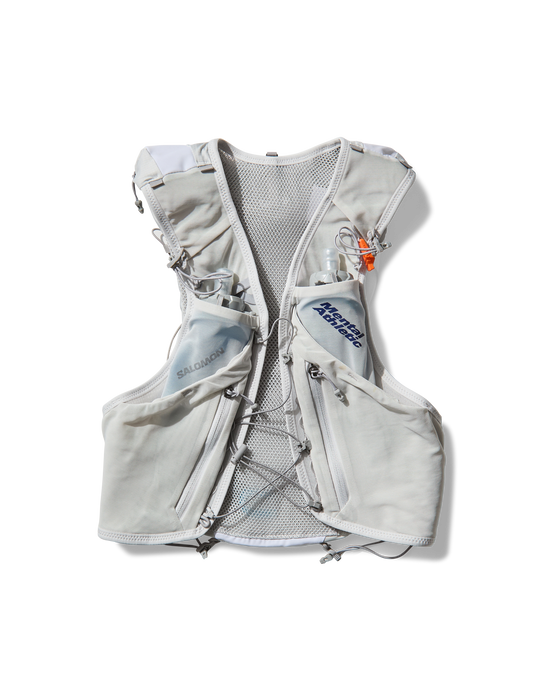MOVE THROUGH

4WD & aNYthing’s Aaron Bondaroff, a seminal figure in New York’s Downtown Culture, and Vince “Bear” Quitugua, founder of cult BJJ’s brand Shoyoroll, met in conversation for Pluralize the Practice — the debut print edition of S-CORP, a platform dedicated to the raw convergence of art, movement, and combat. What began as a personal space for creatives connected through martial arts now expands into practice, archiving the gestures, disciplines, and subcultures that shape contemporary expression.
Lately, there’s been a palpable shift — more and more creatives are immersing themselves in movement not as a wellness trend but as a form of deep discipline. You’re both part of a scene where people move between physical culture and artistic practice — where movement isn’t just a counterbalance to work but a discipline in its own right. For many in this space, repetition becomes ritual, and the body becomes a site of research.

EDOARDO TOTATO: How does this kind of embodied commitment begin to reshape the creative process? And what happens when practice becomes the place where thinking and moving collapse into one?
AARON BONDAROFF: It’s not easy. But it’s beautiful — this collapse of thinking and doing. In certain sports — like jiu-jitsu — you’re forced to be fully present. The repetition, the physicality, the ritual of it… it quiets the mind. And that’s rare, especially for creatives. Our brains are always going. Always on. Sports like these become a kind of meditation — maybe the only time the mind actually gets a break.
When practice becomes embodied like that, it becomes a form of research. You're studying yourself — how you move, how you respond, where you get stuck. It’s humbling. And I think that humility reshapes how you approach creativity too. You stop trying to be the best. You stop trying to control everything. You just show up. You train. You repeat.
There’s something powerful about staying a student for life. You could have a degree, you could know a craft — but there’s always more to learn. I think creative work should feel like that too. Like the body — it has to stay in motion.


VINCE QUITUGUA: When you’re trying to build, learn, or create something with your body, it’s a wild process. The body becomes the vehicle, your emotions are the fuel, and the brain’s just the operating system trying to hold it all together. As creatives, we live in our heads — constantly spinning through ideas, running imaginary equations, exploring possibilities that never leave the sketch phase. But the second you move something into the real world, it’s no longer just a thought — it becomes real.
That’s what’s so unique about jiu-jitsu. When you’re on the mat with someone trying to control or submit you, there’s no space for overthinking. You have to respond, move, survive. You can’t hide in your head. If you hesitate or stay stuck in your thoughts, there’s an immediate consequence — physical, real. You have to be present. That pressure creates clarity.
Creatives are often caught in this loop of endless possibilities — it’s the gift and the curse. You’re constantly imagining, but that flood of ideas can make things cloudy. Back before Photoshop and unlimited undo buttons, if you glued the wrong cut-out on a flyer, that was it — it was ruined. You had to start over. Mistakes cost time and materials, and you had a limited number of tries. That scarcity made you more thoughtful and precise.
That’s what jiu-jitsu brings back to the creative process — the idea that your decisions have weight. You learn to slow down, to be intentional. Because if you aren’t, the cost is often pain. And pain is the best teacher. It locks the lesson in. In the creative world, sometimes we don’t feel the cost of our missteps — which can lead to sloppy thinking or rushing the process.
What I love most is that jiu-jitsu teaches you to try things you suck at — over and over — until you suck less. That’s powerful for creatives. That humility, that patience, that grind… it resets your relationship to the process. It teaches you how to be okay with failing, but also how to fail with focus.
As the late, great Anthony Bourdain once said — "The journey is part of the experience — an expression of the seriousness of one’s intent."

E.T.: What do you think draws artists and designers toward martial arts, and how does this physical engagement inform their output?
A.B.: I think it’s about balance. Artists — creatives — live in their heads a lot. We overthink everything. But when you’re training, when someone’s trying to choke you out or sweep you — your brain has to shut up. You can’t think. You just react. That silence? That’s rare. And I think it’s necessary.
Also, I think there’s something about humility. Not every artist wants to step out of the arena they’re good at. But that’s where growth is. Getting on the mat and not knowing what the hell you’re doing — that’s a reminder that you’re alive, that there’s still something new to learn. And that feeling — of being new at something — I think it’s good for the ego. It brings a different kind of respect.
I had that moment with Photoshop. I never knew how to use it, and then one day I sat down, watched a YouTube video, and finally taught myself. And it hit me — damn, this is real work. It changed how I talked to collaborators. I had more respect for the time that goes into things. And I think martial arts does the same thing — it teaches you to respect process. You start to understand what goes into mastery. That it’s all repetition. Over and over again.
V.Q.: This is something I’ve thought about a lot — especially after years of watching who actually sticks around in jiu-jitsu gyms. I’ve seen all types walk through the doors, and one thing that’s always stood out to me is this: it’s rarely the classic alpha jock who lasts. That guy — the tough, athletic, high-school-sports-type — usually burns out after 3 to 6 months. If they make it to a year or two, that’s rare.
Why? In my opinion, it messes with their ego. They’re used to being the strongest, fastest, most dominant person in the room. Then they come in and get submitted by someone smaller, quieter — maybe a guy who looks like a programmer or someone who’s never played sports in their life. That disconnect kills them inside. They’re not used to losing like that, especially not to someone who doesn’t fit the mold of a tough guy.
The thing is, jiu-jitsu doesn’t reward brute strength or athleticism alone. You can’t just work harder and dominate. There’s always someone with a different rhythm, a sneakier move, a weird angle that throws your whole game off. That’s where creativity comes in — and that’s why I think artists, designers, and non-traditional athletes thrive in this space.
Martial arts, especially jiu-jitsu, is a language of movement. It’s a bunch of positions, transitions, and reactions — but it’s up to the individual to make it flow in a way that works for them. Artists get that. Designers get that. They’re used to building something from scratch, adjusting, iterating. They’re naturally curious. And that curiosity is powerful on the mat.
Some of the best grapplers I’ve seen weren’t athletes growing up. They were finance guys, line cooks, bookworms, government workers — regular people who just committed. They showed up, stayed humble, watched others like them get better over time. They saw creativity beat strength, timing beat speed. And that’s addicting.
Jiu-jitsu is one of the few places where the underdog can truly win — where style, patience, and mindset often beat out raw talent or athleticism. That’s why the creatives stick around. It speaks to how they already think and move through the world.

E.T.: Ever feel like training is just a sanctioned way to disappear from yourself?
A.B.: Absolutely. Meditation is hard. Silence is hard. But some sports — they force it on you. You can’t overthink when you’re sparring. You just are. It’s like the body steps in where the mind usually runs wild.
But it’s not just disappearing. It’s also showing up. For real. You realize you’re not as strong as you thought. Not as flexible. You get humbled. But you’re there. You’re moving. You’re alive. And in that way, it’s a kind of spiritual experience.
I think that’s what creatives need sometimes. To stop performing. To stop curating. And just be in their body. No cameras. No comments. Just breath and sweat and pain.


V.Q.: Yeah… I think about this a lot. As we get older, thinking about ourselves gets harder. When you’re a kid, it’s just you — no filters. But life adds layers. You get into a relationship — now it’s you plus one. Then maybe kids come into the picture, and suddenly it’s you + two or three. Over time, you start blending into the mix of responsibilities. Life happens. You’re doing everything — working, taking care of people, juggling it all — and before you know it, it’s easy to forget who you are in the middle of it.
That’s where training — in any form — becomes something deeper. Whether it’s running, walking, climbing, reading, or just being alone in nature with no phone or noise, that solo time becomes one of the most powerful and underused ways to both hide from and find yourself.
In contact sports like jiu-jitsu, wrestling, or boxing — it gets even more intense. These one-on-one exchanges create feedback loops that are physical and emotional. When your body is literally connected to someone else’s, there’s an energy transfer happening — moment by moment. You’re not just reacting to them, you’re feeling them. Their tension, their calm, their fear — it all shows up in their movement. And you have to respond to that in real time. It's raw, and it’s beautiful. It forces presence.
You can’t fake it. You can’t blame a bad day at work or dodge it with excuses. When you train, you’re forced to deal with you — your thoughts, your breath, your choices. Everything else fades for that hour, and what’s left is just you… asking questions. The why. The how. Is it true?
In a world that constantly pulls us in a hundred directions and makes it easy to disappear, training something hard — something honest — is one of the few ways to truly show up. It brings us back to ourselves. Not always comfortably. But always truthfully.
E.T.: What sparked the idea to Pluralize the Practice, and what does the project mean to each of you on a personal level?
A.B.: I’ve known Bear a long time — from the Shoyoroll world and beyond — and we were talking about doing something together. And I started thinking about language, especially growing up in New York. I always was curious why and how slang pluralized things — “my mans and thems,” “Heads”, “Shorties”. “Cribs”, “Whips”, “Stacks” — street slang. I realized It was a way of manifesting abundance. Put an “S” on it, and suddenly it’s more.
So I thought, what happens if we pluralize the practice? Practices. It’s about recognizing that mastery comes through doing — over and over. Whether it’s skating, writing, photography, or fighting — nobody’s just good. They become good. Through repetition. Through ritual. And I wanted to honor that.
We knew so many people who had creative practices and martial arts practices. Photographers who train, writers who roll. So we wanted to make something that merged those worlds. Not to explain it, but to just show it. Like a blog. Old-school. Tumblr vibes. No big production. Just: send us what’s on your phone.
And then, we surprised everyone with a book. We didn’t tell them. We just made it. That way, people didn’t overthink what they sent. It was raw. Instinctual. Honest. And that’s the energy I wanted — that looseness, that trust. Because if you say “we’re making a book,” people tighten up. They want perfection. But we wanted process. The mess. The real.
For me, it was about keeping the people around me excited. Wowing your friends. That’s the first audience that matters.

V.Q.: For a long time — whether we realize it or not — it’s been hard not to be influenced by the things Aaron has touched. As a California West Coast kid raised on the island of Guam, I saw firsthand how his work shaped the culture we move in today. His ideas, his style, the way he thinks — it’s influenced how we build, create, and connect. I’ve respected his work for years and have been lucky enough to collaborate with him on past projects that always felt real, original, and never forced.
After a bunch of back-and-forths over time — a lot of good conversations — Aaron hit me with a simple idea: “Let’s bring back the old-school blog. Let’s invite our friends. Let’s make it a community.”
We’ve been trying to bridge these two worlds for a while — where wellness and training meet grappling and martial arts. At our core, we’ve always been shaped by surfing, skateboarding, and combat sports. In the early days, we even printed SURF, SKATE, SCRAP on our tees — because that was us. This project is just a reflection of that energy — the intersections, the fringe zones, the people and practices that don’t fit neatly into categories. We wanted to create a space that felt like home for that kind of creative chaos — a place where surfers, skaters, grapplers, thinkers, and builders could all meet up.
The mission behind this project is simple but powerful: blend worlds that don’t normally blend — and just see what happens.
Maybe it works. Maybe it doesn’t. That tension, that unknown — that’s the spark. And for me, it’s always been about walking that line between what you know and what you’re still trying to figure out.
We didn’t want to force it. Didn’t even want to name it at first. We weren’t trying to launch something. We just wanted to put it out there. No big plan. No pitch deck. Just vibes and community. Because the second you overbrand something, it turns corporate and boring. And that’s never been the point.
That’s where the blog name S-CORP came from — a little spin Aaron cooked up, playing off the “S.” The letter S meant a lot to us. It stood for the things we loved and the idea of practicing many things, not just one lane. That’s how “Pluralize the Practice” and “Put the S on Everything” came to life. The S became a symbol for keeping it open, expansive, and never boxed in.
So yeah — after tossing names around, Aaron being Aaron, he landed it:
Pluralize the Practice.
Put the S on everything.
The rest? We just started building. No roadmap. No expectations. Just building. Letting it grow where it wants to go.
E.T.: What about the Universal Grappling System? How did it come up?
V.Q.: UGS — the Universal Grappling System — is a proprietary system and philosophy of training developed by myself and Dr. Iwasaki, a leading expert in biomechanics and high-performance coaching with over two decades of experience working with elite athletes across multiple disciplines. I’ve personally been immersed in Brazilian jiu-jitsu for over 20 years as both a student and teacher, constantly experimenting with ways to evolve how the art is shared.
Together, we spent years examining how jiu-jitsu and grappling were being taught globally — from traditional academies to emerging schools experimenting with more modern methods. What we saw was a gap: most programs either leaned too heavily on outdated, rigid systems or lacked enough structure to be effective for new students. So we set out to build something different. After nearly a decade of trial, error, and iteration, UGS was born — a modular, adaptable, and accessible system built on the principles of movement, interaction, and creativity.
UGS isn’t just a training program — it’s a mindset and method. In less than a year, it’s already in use at over 40 gyms worldwide, from startup academies to some of the most respected institutions in the space. Its appeal is in its simplicity and flexibility. Whether you're a complete beginner or a high-level competitor, the system meets you where you’re at — creating a shared platform that partners of all levels can learn and grow from together.
If your favorite HIIT class had a baby with a flow-based yoga session, you’d get something close to UGS. It’s structured enough to build real skill and progress, but fluid enough to invite exploration and personal expression. More than anything, it's designed to lower the barrier to entry and make grappling more welcoming — especially for people who might otherwise feel intimidated by traditional martial arts environments.
Ultimately, UGS is about pluralizing practice — offering a fresh, progressive framework for movement-based learning that’s just as much about connection and creativity as it is about technique.

E.T.: Grappling emphasizes adaptability — responding fluidly to an opponent's movements. Has this principle influenced your approach to diverse cultural expressions?
A.B.: It’s funny — my six-year-old nephew does jiu-jitsu. And I always think, man, if we all started younger, we’d walk through life totally different. We wouldn’t need the ego, the fronts, the street armor. You learn to move with energy. To flow with difficulty. Not fight it.
And that translates. Into how you talk. How you collaborate. How you handle conflict. You’re not reacting out of fear or ego. You’re reading the situation. Adjusting. Grappling teaches you that — to work with what’s there, not against it.
I came to it late in life, but I’m grateful. It chilled me out. And I wish I had it earlier, but maybe I wasn’t ready. Maybe I’d have been dead. Who knows? But I know now — it’s a gift. Especially for the younger generation. You give them this kind of practice, and it gives them back a whole new way to walk through the world.
V.Q.: Absolutely. Grappling forces you to be in the moment. It changes by the millisecond. And in today’s world — with culture evolving fast and AI shifting everything — adaptability is everything. If you hold onto old ideas too tightly, you get left behind. In grappling, the only constant is change.
E.T.:There’s a moment in combat sports — especially during sparring — when it stops being about domination or winning. When the rhythm shifts, it becomes something closer to a dance or a conversation. That’s where real growth happens. That’s where you have fun.
Can you describe that shift? When your body starts listening as much as it moves?
A.B.: It’s funny — sometimes you roll with someone who really knows what they’re doing, and there’s this flow. Like a conversation without words. You’re moving together, reading each other. And then sometimes, you roll with someone who doesn’t know what they’re doing, and it’s way more chaotic. But even then, it’s a connection. Two people trying to figure something out.
It’s humbling — almost embarrassing, in a good way. You’re there, tangled up with another human being, trying to do this thing neither of you fully controls. But once you get past that discomfort, once the ego shifts, there’s space for something deeper to happen. A breakthrough.
I think if you can get comfortable with losing — really get used to it — that means you’re actually winning. Winning is just the icing on the cake. The real win is showing up. It’s being okay with not being the dominant one all the time. That’s the ego again. But when you let that go, it’s freeing. Uplifting, even.
When you’re a kid, and you lose a fight on the street, you show up to school the next day thinking everyone’s talking about it. But the truth is — nobody cares. That’s a powerful lesson. Losing is a part of life. A big part of this sport. A big part of growth. Nobody wants to lose, sure — so maybe just avoid fights altogether. But if you’re in it, learn the lessons, to lose well.
V.Q.: With time, the stress starts to fade. You begin to trust your body — even in the weirdest positions. That’s when it turns into flow. It’s like surfing. When a wave comes, you don’t fight it — you ride it or get out of its way. Grappling is the same. You’re not just reacting — you’re responding. You have options: fight, flow, or freeze. Once you learn to flow and only the body will know when the mind begins to understand, it becomes a dance. A living game of human chess.
E.T.:Does the total-body workout mentality influence the way you work, create, or even just show up?
A.B.: I mean, just show up, man. I say that a lot: just show up. That’s really the most important thing. There are days when I don’t want to train, don’t want to practice, whatever it is — but when I push through and actually do it, I feel so much better. You can’t buy that kind of therapy. You just can’t. And unless you do something like this — a sport, a discipline — you might not understand how real that is.
Your mind’s always trying to negotiate with you, right? Telling you, “Ah, go tomorrow, go later, just skip today.” But if you stop listening to that voice and just go, it changes everything. And I think that applies to creative work, too. Like with writing — sometimes I put it off because I know that once I start, I have to really start. I have to be in it. And that can be intimidating. But once I begin, it feels amazing. Because I’m doing it. That’s the thing — it’s the same as training.
The mind is the real obstacle. But the reward — that rush, the endorphins you get after showing up to train — you can get that through creativity, too. It’s not physical in the same way, but the feeling is similar. It’s movement. So if you’re procrastinating creatively, go train. And if you’re putting off training, try creating something. They go hand in hand. They feed each other.
V.Q.: Absolutely. Physically, it’s good for your heart, your body, all of it. But the real value is in how it trains your mind — your breath, your calmness under pressure helps maintain the soul. That clarity transfers into every part of life: work, relationships, creativity. It sharpens you for life.

E.T.: Balancing the depth required for mastery in one area with the breadth needed to innovate across various fields can be challenging. How do you both keep going deep in one practice without getting stuck, while also exploring new territories?
A.B.: I always say: student for life, man. With jiu-jitsu, that’s really what it is. You’re in it for life. That’s the scary part. I remember when I first tried it, just to feel it out — and then Bear sent me a kimono, and I was like: “Shit. That means I’m doing this forever.”
This isn’t like swimming or cycling, where you can just hop in and out whenever. Jiu-jitsu demands something else. It’s more like skateboarding in that way — you’ve gotta stay with it. You have to stay connected to it. With skating, if you stop, your body forgets. You lose that edge. It’s not just muscle memory — your whole body has to be conditioned for it. Jiu-jitsu’s similar in that sense, but also different: if you stay with it long enough, it becomes something you carry with you. For life.
And the wild thing is, the deeper you go, the more you realize — it’s not about going harder, it’s about going smarter. Like, you just found out — it’s about breathing, relaxing. Not everything has to be this aggressive, urgent push. Sometimes the real skill is learning how to move slower, conserve your energy, see the openings. That’s how you last. That’s how you build longevity — in training, and in life.
So yeah — it’s all about balance. Don’t rush it.
V.Q.: Sometimes, you hit a wall in something you’re good at — or you go too deep into one thing, overcommit, and start wondering if it’s helping or hurting. But with time, you start to feel it… that it’s time to move on. The best people I’ve seen are the ones who can step away from what they’re great at, just to go work on the stuff they suck at — because that’s how you learn to play the whole game.
The answer is to intentionally suck at something new — new positions, new situations, different areas of practice. And yeah, it hurts. It’s rough to go from feeling sharp in one zone to feeling completely lost in another. That struggle can feel like a setback… even a kind of sadness. But if you stick with it, that sadness turns into fuel. It gives you a new kind of energy.
And when you circle back to what you were originally good at — you see it with new eyes. New layers. That’s the beauty of grappling: one day you’re the hammer, the next day you’re the nail. But either way, you’re learning. You’re growing. And it’s not really about what you want to happen — it’s about what shows up. And how you meet it.

E.T.:They say the mat doesn’t lie. What’s it shown you about how each of you handle pressure, ego, collaboration? And how’s that tracked with how you’ve moved through scenes over the years?
A.B.: When I used to run an art gallery, I’d ask my friends to make work for me or be a part of an exhibition — but sometimes they’d say no. And I used to get upset about that. I took it personally. But over time I learned that it’s okay. People have their own opinions, their own paths, and their own boundaries. That’s just part of life.
I think that lesson applies to training too — to the mat. You’re not always going to get what you want. You can’t control everything. What you can do is accept what comes your way and find opportunity in it. Even when you’re in a bad position — in jiu-jitsu, in boxing, whatever — there’s something to be gained. Maybe it’s a chance to try a different move. Maybe it’s a lesson in patience. Or maybe it’s just learning to stay calm under pressure. To me, that’s a huge part of humility. It’s about understanding that no matter how good you are, there’s always room to grow. Always something to learn.
V.Q.: The mat always brings you back to zero. No matter how high you get in life, training resets you. You can’t fake it. It shows you your best and worst — and forces you to own both. Sometimes you’ll blame your partner for a bad round, but deep down, you know it’s on you. That honesty is rare, and it’s sacred.
E.T.: Has training — really training — changed the way you understand community?
A.B.: Once you meet someone who trains — in anything — you respect them differently. You can feel the dedication, the discipline, the passion they bring just by the practice. This shit is hard. Whatever the practice is, doing something consistently is one of the hardest things there is. So anyone who trains, even if you don’t like them personally, you still respect them. There's this unspoken understanding.
I was saying this earlier — people who commit to bettering themselves, in any way, are rare. It takes courage. Most people don’t have that drive or even the curiosity to try. So when you find someone who’s putting in that kind of work, it’s inspiring. It becomes a kind of community based on mutual respect — a community built around self-care, discipline, and growth.
And when I meet someone who trains — who really trains — I want to learn from them. It doesn’t matter if they’re a white belt or a black belt, we can all learn from each other. Sure, we might call someone the teacher or the professor, and others the students — but the truth is, everyone brings something valuable to the mat. That’s what makes this community so powerful.
V.Q.: Yeah, 100%. Training builds a bond that’s hard to explain. You’re out there trying to break each other — but also protecting each other at the same time. You push, sweat, bleed, and grow together.
In real life, you get to choose who you spend time with — your friends, your coworkers, your circle. On the mat, you don’t get that luxury. You don’t get to handpick who shows up. You train with whoever’s there. Big, small, beginner, savage — doesn’t matter. You have to mix. You have to do something hard together. And you can’t run from it like you sometimes can in everyday life.
That kind of shared struggle — day in and day out — creates a bond that’s different. A real tribe gets built, not because you chose each other… but because you went through something together.

Photo by Toni Brugnoli
Interview by Edoardo Totaro













